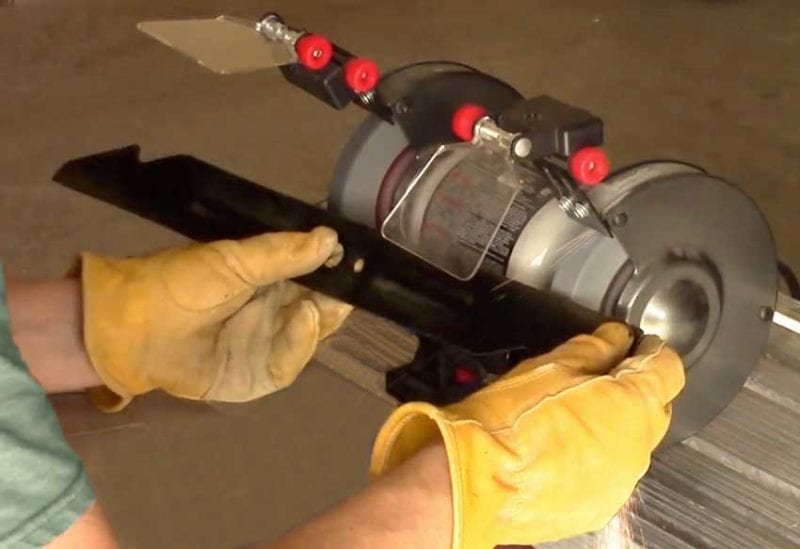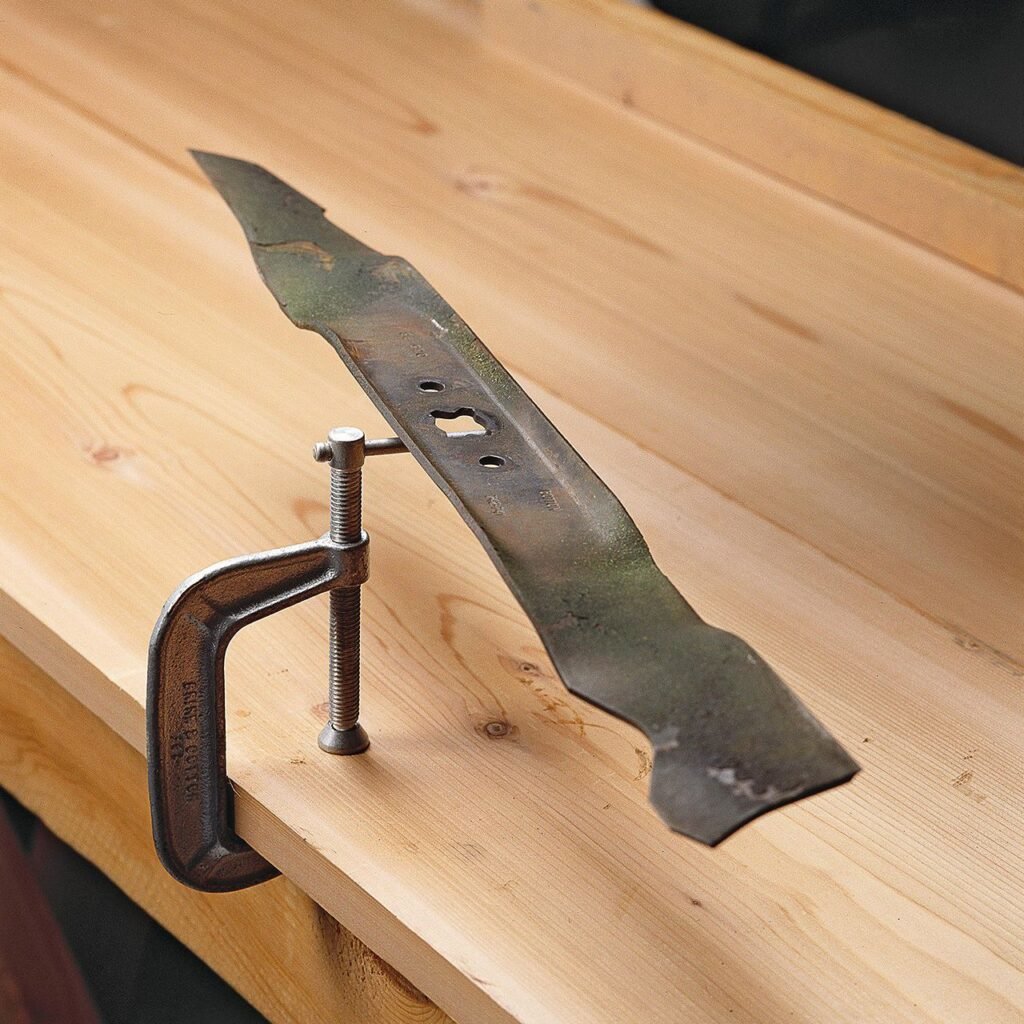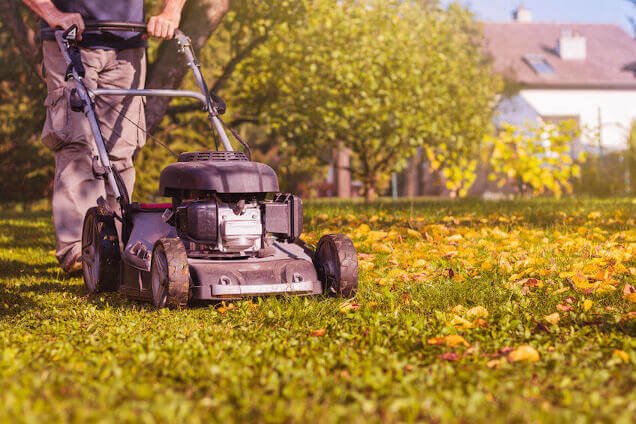This guide will teach you exactly how to sharpen your lawn mower blades at home using a few different tools and methods.
Sharp lawn mower blades are essential for the cut quality of your lawn and the efficiency of your mower.
Sharp mower blades are also very important for the lawns health. A dull blade can tear the grass instead of slicing it, leaving it susceptible to diseases and unnecessary stress.
Key Takeaways
- Proper mower blade maintenance keeps helps keep you lawn healthy.
- Different methods of sharpening lawn mower blades.
- Techniques for blade removal, sharpening, balancing, and reassembly for optimal performance
Removing Lawn Mower Blades
Secure the Mower
Before starting the process of removing your lawn mower blades, you’ll need to make sure the mower is properly secured. First, disconnect the spark plug to prevent any accidental ignition.
Next, tip the mower onto its side, with the air filter and carburetor facing upward to prevent oil and fuel from leaking. We like to unscrew the gas cap and screw it back on with a plastic bag underneath.
If necessary, you can place a piece of wood or a brick under the mower deck to keep it stable during the blade removal process.
Removing The Lawn Mower Blade Properly
To remove the lawn mower blade, you will need a wrench of the appropriate size (usually a 1/2-inch or 9/16-inch socket) to loosen the bolt or nut holding the blade in place.
Pro Tip: To prevent the blade from moving while you are loosening the bolt or nut, you can use a piece of scrap wood to hold the blade in place. Simply wedge the wood between the blade and the mower deck, and it will prevent the blade from turning as you loosen the bolt.
Once the bolt is removed, you can carefully take the blade off the mower. Note the position and orientation of the blade, as you will need to install the replacement or sharpened blade in the same manner.
By following these steps, you’ll be able to remove your lawn mower blades safely and efficiently, making it easier to maintain your mower and keep your lawn looking its best.
Blade Sharpening Techniques
Using a File
While using a metal file is by far the slowest way, it is the easiest way.
With the blade securely in place, begin filing the cutting edge using long, smooth passes in a single direction—from the inside edge to the outside edge.
Make sure each stroke removes a thin layer of metal, revealing a clean, shiny edge. Flip the blade and repeat the process on the other side. Remember to keep the same number of strokes for each side to achieve a balanced and evenly sharpened blade
Using a Bench Grinder
Before using a bench grinder to sharpen your lawn mower blade, make sure to wear protective goggles and gloves.

When using a bench grinder, maintain the correct angle by gently pressing the cutting edge of the blade against the spinning grinding wheel.
Move the blade back and forth until it is sharpened evenly, as you grind the blade the metal may heat up and weaken, so keep in mind you want the sharpening process to take only a few minutes or the blade will become weak.
After sharpening both sides of the blade, perform a balance test. If needed, remove more material from the heavier side of the blade until balanced.
Using A Power Drill & Attachment
Utilizing a regular power drill with sharpening blade is another efficient method for sharpening lawn mower blades.
I found the easiest way to secure the blade is in a table clamp or vice. Slowly approach the mower blade with the power drill already spinning and begin cutting the edge of the blade at the original angle, moving it evenly back and forth until the blade is sharp .
Flip the blade and repeat the process for the other edge. Make sure you don’t push too hard when sharpening, or you make take large chunks out of the blade. Keep your passes smooth and consistent.
Finally, always perform a balance test to ensure an evenly sharpened and properly functioning blade, more on this in the next section.
Blade Balancing
Why Balancing A Lawn Mower’s Blade Is Important
Balancing your lawn mower’s blade is crucial for maintaining its performance and ensuring an even cut on your lawn. An unbalanced blade can cause vibrations that may damage your mower’s engine and decrease its lifespan.
Furthermore, an imbalanced blade can result in uneven cutting, leaving your lawn looking patchy and unkempt. It can also become very uncomfortable to operate your lawn mower properly.
How to Balance Blades

- Clean the blade: Before balancing, ensure your blade is clean. Remove any grass clippings, dirt, or rust using a wire brush or sandpaper.
- Sharpen the blade: If the blade is dull, sharpen it using a file, bench grinder, or angle grinder, keeping a consistent angle of around 45 degrees. Ensure the blade is sharp, but not too thin as this can weaken it.
- Check for balance: There are several ways to check if your blade is balanced. One method is using a blade balancer, which is a simple tool that holds the blade horizontally. If one side of the blade dips, it’s heavier and should be filed down to match the lighter side. Alternatively, you can balance the blade on a nail or screwdriver, observing if it leans to one side.
- Adjust balance: If the blade is unbalanced, file the heavier side until it’s level. Remove small amounts of material at a time and recheck the balance frequently to avoid overcorrecting.
- Reinstall the blade: Once the blade is balanced, reinstall it on your lawn mower, making sure it’s tightly secured. Always remember to disconnect the spark plug before handling your mower’s blade to prevent accidental starting.
By properly balancing your lawn mower’s blade, you can ensure a flawless cut, protect your engine, and extend the life of your mower.
Reassembly and Maintenance
Reattach The Mowers Blade
After successfully sharpening your lawn mower blades, it’s time to reattach them. Make sure the blades are dry and free of any debris before reassembly.
First, secure the blade with a block of wood to prevent it from moving. Then, align the mounting holes of the blade with the spindle on the deck of the mower. Hold the blade in place and insert the bolt or nut through the mounting hole. Then simply tighten your bolts.
When Should I Replace My Lawnmower Blades?
You should consider replacing them if they exhibit signs of damage, such as cracks, bent sections, or excessive wear.
If the blade is beyond sharpening or has been sharpened to the point where it’s too thin or weak, it’s time to replace it with a new one.
What tools are required to manually sharpen a lawnmower blade?
To manually sharpen a lawnmower blade, you’ll need a few tools, such as a metal file, grinding wheel or powered drill with a grinding attachment.
You’ll also need a vice to hold the blade securely in place, work gloves to protect your hands, and safety goggles to protect your eyes while sharpening.
Is it necessary to remove the blade from the mower to sharpen it effectively?
Yes, it is necessary to remove the blade from the mower to sharpen it effectively. By doing so, you can easily access the cutting edge and hold the blade securely in a vice. You also need to balance the black, which is impossible to do without removing the blades from the mower.
What is the recommended angle for sharpening a lawnmower blade to ensure optimal cutting?
The recommended angle for sharpening a lawnmower blade is typically between 30 to 45 degrees. It’s important to maintain the existing angle of the blade’s beveled edge to ensure proper cutting performance and to avoid wobbling.
How do you determine if a lawnmower blade is sharp enough without making it overly sharp?
A lawnmower blade should not be razor-sharp; It only needs to have a tapered edge to ensure an effective cut. A properly sharpened blade will cut grass cleanly, whereas a dull blade will tear the grass, leading to an uneven cut.
How many times can a lawnmower blade be sharpened before it needs to be replaced?
The number of times a lawnmower blade can be sharpened before it needs to be replaced depends on factors such as the blade’s quality and how often it is used.
You’ll know when a blade needs replacing if its thin and weak, has many chunk or chips missing that you can’t eliminate by sharpening. Warped blades that are hard to balance may also require a replacement.


